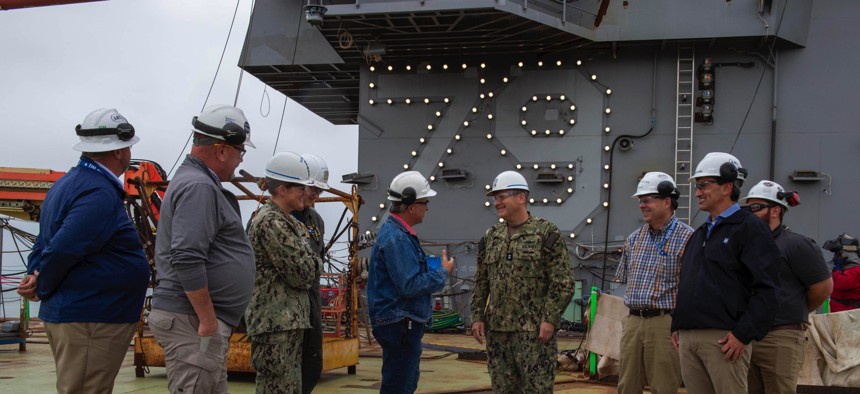
Naval Sea Systems Command's Rear Adm. Tom J. Anderson, discusses the construction of the aircraft carrier John F. Kennedy (CVN 79) with HII team leaders in Newport News, Virginia. U.S. Navy / Mass Communication Specialist 2nd Class Tyler Slavicek
Delaying aircraft carrier order would hurt supply chain, shipbuilder says
HII says key suppliers could close up if Navy decides to push back CVN-82 order.
Suppliers of critical parts for Ford-class aircraft carriers could suffer if the U.S. Navy delays a planned buy of the multibillion-dollar ships, executives from shipmaker HII said Monday.
The delayed purchase would be the latest blow to a sector that’s still recovering from numerous pandemic-driven supply chain disruptions.
“I think the budget is driving discussions around [the] potential delay,” HII CEO Chris Kastner told reporters during a Monday briefing. “One thing we should never delay is the advanced procurement of major equipment in the supply chain.”
The Navy’s acting acquisition chief, Jay Stefany, recently said the service is weighing when it should buy its next two Ford-class carriers, CVN-82 and CVN-83. The Navy has already purchased four.
It is “extremely disappointing” to hear that the contract to build CVN-82, which was expected in fiscal 2028, might instead slip to 2029 or 2030, a Newport News shipbuilding executive said. The delay would be “detrimental” to the entire nuclear shipbuilding industry, including submarine construction.
Nearly half of HII’s suppliers “already risk going cold,” the executive said, and a delay of CVN-82 would undermine the fragile industrial base. HII doesn’t expect any of its suppliers to close up shop this year or next, but “it’s very close to that.”
“It's very concerning, especially considering that more than half of our suppliers support both aircraft carrier and submarine construction,” the executive said. “Any delay to aircraft carrier contracts is likely going to have an equal and maybe more impactful impact on submarine construction.”
Company officials are trying to persuade the Navy to order two ships this year, provide at least three years of advanced procurement funding for them, and expect four-year build intervals between deliveries—what they call a “2, 3, 4” plan.
“We know that ships are going to be built,” Kastner said. “They have broad support, so let's eliminate risk. Let's get the major suppliers under contract early enough so they can plan and they can make their production schedules, so I think there's a broad understanding of that.”
HII is the only U.S. company that builds aircraft carriers.
The Navy purchased CVN-80 and CVN-81 at the same time—the first block buy since the Cold War—by persuading Congress that it would save $4 billion. But supply problems during the COVID pandemic put construction of CVN-80 roughly a year behind schedule.
The delay is hiking construction costs, the executive said, but declined to say how much. CVN-81 remains on schedule, the company said.
HII touted the importance of aircraft carriers, noting how the maiden deployment of Gerald R. Ford was extended three times by the defense secretary. The Ford carrier strike group is returning home from the eastern Mediterranean, where it was sent after Hamas’s Oct. 7 attack on Israel.
Company executives also discussed the health of the shipbuilding industrial base, which is facing a heavy load as the Navy tries to balance building new aircraft carriers and other surface combatants with Columbia- and Virginia-class submarine construction. Kastner said HII needs the money in the broader defense supplemental package to meet the Navy’s production goals for submarines. That money is in limbo on Capitol Hill as lawmakers argue over Ukrainian aid in the package.
“The $400 million in the 2024 budget for [the submarine industrial base] and then the over $3 billion in the supplemental for [the submarine industrial base], are directly related to ensuring that we can make the rate, predominantly Virginia-class, but Columbia-class and AUKUS submarines in the future,” Kastner said.
HII is also waiting on the 2024 budget to authorize $1 billion so the Navy can finish buying LPD-33, the next San Antonio-class amphibious assault ship. The correct size of the future amphibious fleet has been a sticking point between the Pentagon and Congress in recent years. In its 2024 budget, the Navy “paused” the construction of more LPDs until additional studies are completed. Historically, buying amphibious ships has been last on the list for the Navy as it prioritizes aircraft carriers, submarines, and destroyers.
Kastner said there is “broad agreement” that the Marine Corps needs at least 31 amphibious ships.
“We believe that that number should be protected in the budget, but again, details to follow, and I know that a lot of steps need to get done before the budget gets complete, but keeping the amphib line going is very important to Ingalls [Shipbuilding],” he said.
Kastner said he has not yet seen the Navy’s study on amphibious ship requirements, which has been provided to Congress but not released to the public.
“I’m waiting,” he said.




